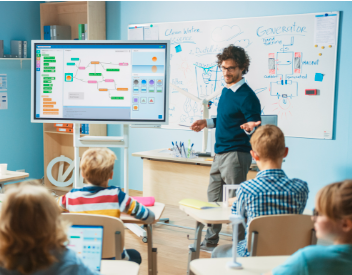In today’s technology-driven learning environments, digital whiteboards are transforming how teachers engage with students. These modern tools go beyond traditional chalkboards, offering dynamic features that enhance lessons and make learning more interactive and accessible.
What Are Digital Whiteboards?
Digital whiteboards, often known as interactive whiteboards or smart boards, are large touch-sensitive screens that connect to a computer and projector. They allow educators to display images, videos, websites, and other digital content. Teachers can write directly on the screen with a stylus or finger, save annotations, and even share lessons in real time.
Enhancing Engagement and Participation
One of the biggest advantages of digital whiteboards is their ability to capture student interest. Visual learners benefit from diagrams and videos, while interactive elements encourage hands-on participation. Whether solving math problems together or exploring historical timelines, students can collaborate at the board, fostering group learning and critical thinking.
Improving Lesson Flexibility
Digital whiteboards make it easier to adapt lessons on the fly. Teachers can instantly pull up resources, highlight key points, or revisit previous content with just a few taps. This flexibility supports differentiated instruction, helping meet diverse learning needs in the classroom.
Encouraging Collaboration
Many digital whiteboards allow for multiple users to interact with the board simultaneously. This means students can work together on a problem, brainstorm ideas, or present their findings in front of the class. Collaborative tools encourage communication skills and teamwork—key abilities in today’s world.
Saving and Sharing Content
Unlike traditional boards that are erased after each lesson, digital whiteboards let educators save their work. Lessons can be emailed, uploaded to a learning management system, or printed for later review. This feature supports students who need to revisit material and helps parents stay informed about classroom activities.
Supporting Inclusive Education
For students with learning differences, digital whiteboards offer tools such as text-to-speech, magnification, and multilingual support. These built-in features help ensure every student has a fair opportunity to understand and participate in lessons.
Preparing Students for a Digital Future
As workplaces increasingly rely on digital tools, introducing students to smart technology in the classroom helps build comfort and confidence. Digital whiteboards offer a natural bridge to the types of technology students will use in higher education and future careers.
Conclusion
The integration of digital whiteboards in classrooms represents more than a tech upgrade—it reflects a shift toward more engaging, adaptable, and inclusive learning. By enhancing instruction and encouraging collaboration, these tools play a powerful role in shaping the future of education.














